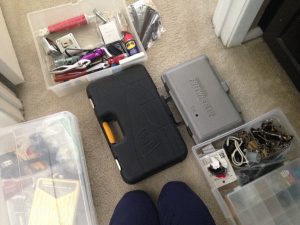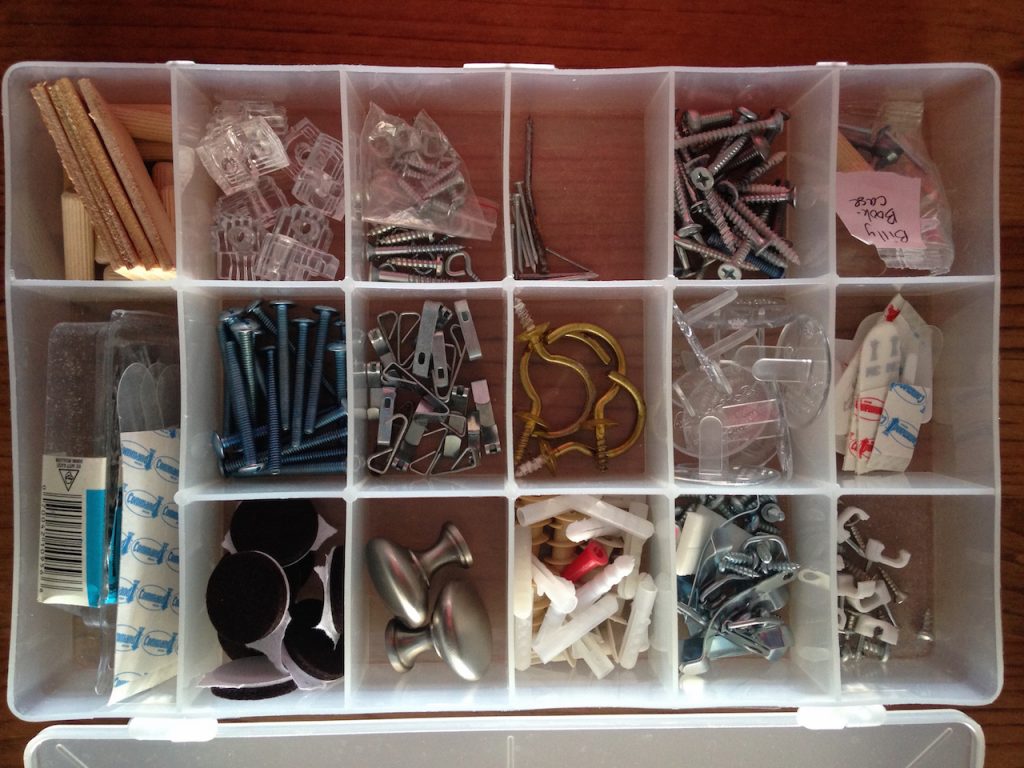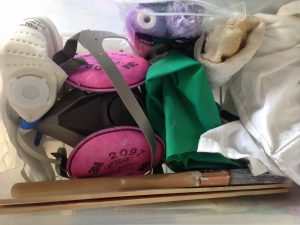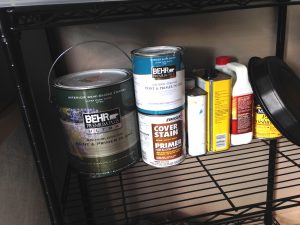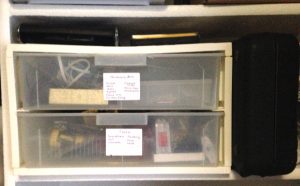These two KonMari categories, hardware/tools and stationery, seem similar to me because they are both equipment. They probably seem more akin because we have always stored them in the same cupboard: come to think of it, both in our previous flat and here.
Let’s start with tools. For me this includes actual tools, like hammers, screwdrivers, etc., as well as little bits like nails and picture hooks, and a selection of painting supplies.
Because it represents practical items, this category is both easier and harder. Easier, because it’s not particularly sentimental; harder, because trying to figure out if these things spark joy – and then, separately, whether you need to keep them – feels more obtuse.
One pitfall I have noticed with practical items like these is that it’s easy to lose focus on the task of discarding, forgetting about joy and reverting to practical assessments: Do I need it? How often will I use it? Kondo does allow for keeping certain practical items out of necessity, rather than because they spark joy (this discussion is in her second book, Spark Joy), and even uses a screwdriver as an example. But I feel like she treats these as a few exceptions, rather than allowing a whole category to be exempt from joy-sparking. So what I’ve tried to do in these cases is to consider how much joy something gives me, and then secondarily consider whether I need it.
Personally, I feel that some tools can spark joy. Some definitely don’t, like all those Ikea wrenches. For those, I decided to discard as many as I could, but checked beforehand against our other tools to make sure we had another that would do the same job. We have a few of those hexagonal wrench things as part of tool sets, so I think we still have every size we need, without all the extra freebie ones. I had to consult Mike as well for a few items, since some of the tools were his and used for his projects.
I discarded plenty, like duplicate screwdrivers and measuring tapes, old rusty bent nails, and plastic bits I no longer remember the purpose of. The KonMari requirement to take everything out is particularly good at forcing you to deal with those little things that collect in corners, like rusted nails and extra bits and nubs and pips…I’m making up words because I can’t really characterise these things, but do you know what I mean? Normally, because these items are peripheral and seem ‘few in number’ relative to the main things, I tune them out. When I’m forced to dump everything out, however, all the peripheral items emerge and I can weed them out.
Here’s the lovely box of small things:
I almost didn’t go through my painting supplies. They’re out in the shed, it’s yucky there, there wasn’t much stuff…Almost. But at last, I did, and got rid of a couple of used rags and stirrers, and made everything neat.
I had a vision for our tool storage to move from its place next to the stationery and into our hall closet. As always, everything fit perfectly, right down to the thin things that slid in the little gaps. The tools’ former home now houses the toys that live in the living area. Of course they’re scattered around, for much of the time, but at least we have the option of putting them really away. I’m very happy!
A view of the tools’ new home: not glamorous, but nice and compact. Recognise the sagging plastic drawers? It’s another set like the ones in the bathroom that I hate. No love there, but better than nothing for now.
Second, I went through stationery. This is a more fun category. Although, here again, practicality reared its head. I had some extra notebooks and such…but isn’t paper always useful? For grocery lists if nothing else. And what about my huge collection of binders and dividers?
I did my best to select items I really liked to keep, ones that I felt I’d enjoy using and not just use out of duty. I have some pretty notepads that I kept for making grocery lists. I discarded a little notepad that is the last of its kind…at a summer job in Oxford I gleaned a bunch of free notepads, enough that I used them daily throughout my whole PhD to make lists and schedules. We’re talking years of daily use and I still had one left. Those notebooks! Never ending! It evoked happy memories, funny memories of frugal times, and I decided I was past using any more of those notepads.
Here’s the before and after of our drawers where we keep pens, scissors, etc. It’s not as striking a transformation in the photos as I would like. I swear there’s a lot less there! But perhaps more to the point, several things are easier to access, like the big tray of coloured pencils you see in the after photo, which were in rubber-banded clumps and boxes before, but can now be easily lifted out in their box (a shoebox lid).
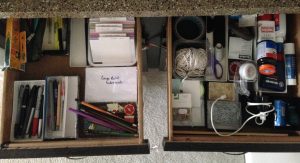
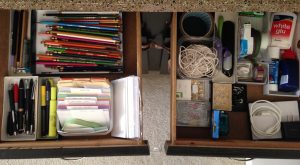
An interesting thought struck me regarding binders. I have over a dozen now, since clearing out my academic papers. Typically I keep some because there’s always something you need a binder for, right?! But since I’m clearing out EVERYTHING, there won’t be any lurking pockets of paper that need organising. By the end of this, every paper will have a home. And aside from one or two binders for the occasional project (I kept a binder to organise our move last year, for example), I really won’t need a huge stash.
Here’s the cabinet below, where I keep larger stationery items. Again, not a huge difference in appearance, but things are easier to access because there’s no horizontal stacking: everything is either in a drawer or box which can be pulled out, or standing vertically like books.
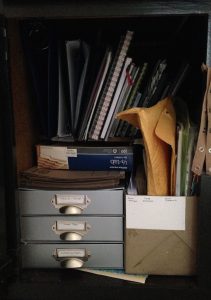
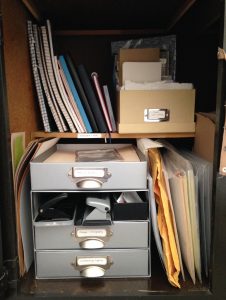
I like before-and-after photos, but I don’t think they always do justice to the result of tidying like this. For one thing, right now I’m not spending too much time organising, just enough to get everything put away neatly. Organising is a different phase, and then I’ll reassess some of these spaces and perhaps make them prettier.
But perhaps not. A curious effect of the KonMari method is that, even when spaces don’t look markedly different in a photo, they feel very different to me. They feel clean and restful, like every item is reposing. Any bad feeling I might have had – like guilt or dread about the items or their disorder – is gone. I feel this is a great benefit, and more important than how the space looks to anyone else: after tidying up this way, I always feel much happier about my space.
Next up: I think I’ll take on my cleaning and laundry supplies.
